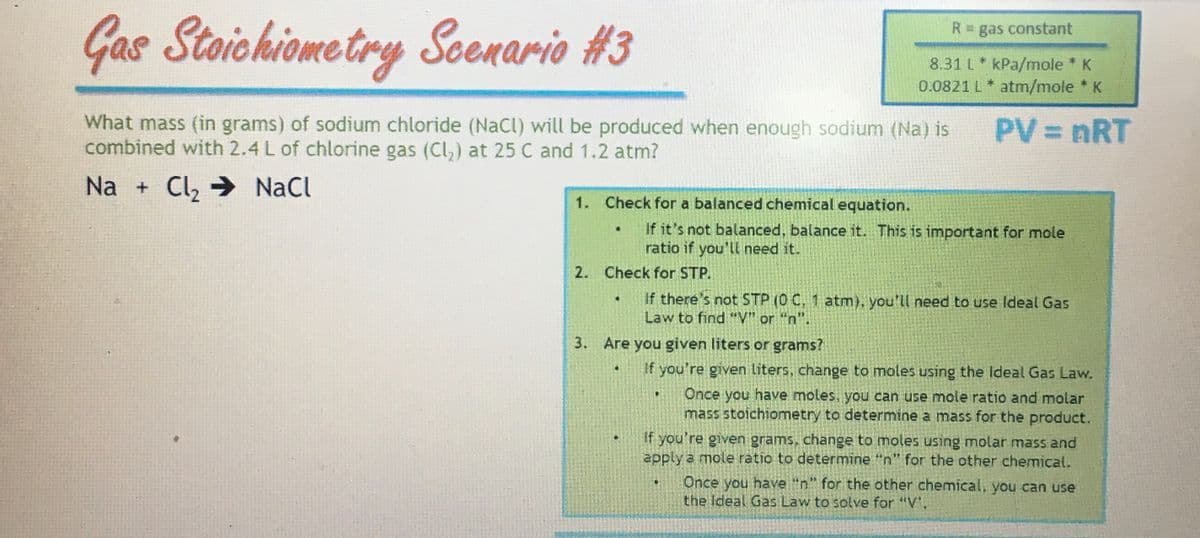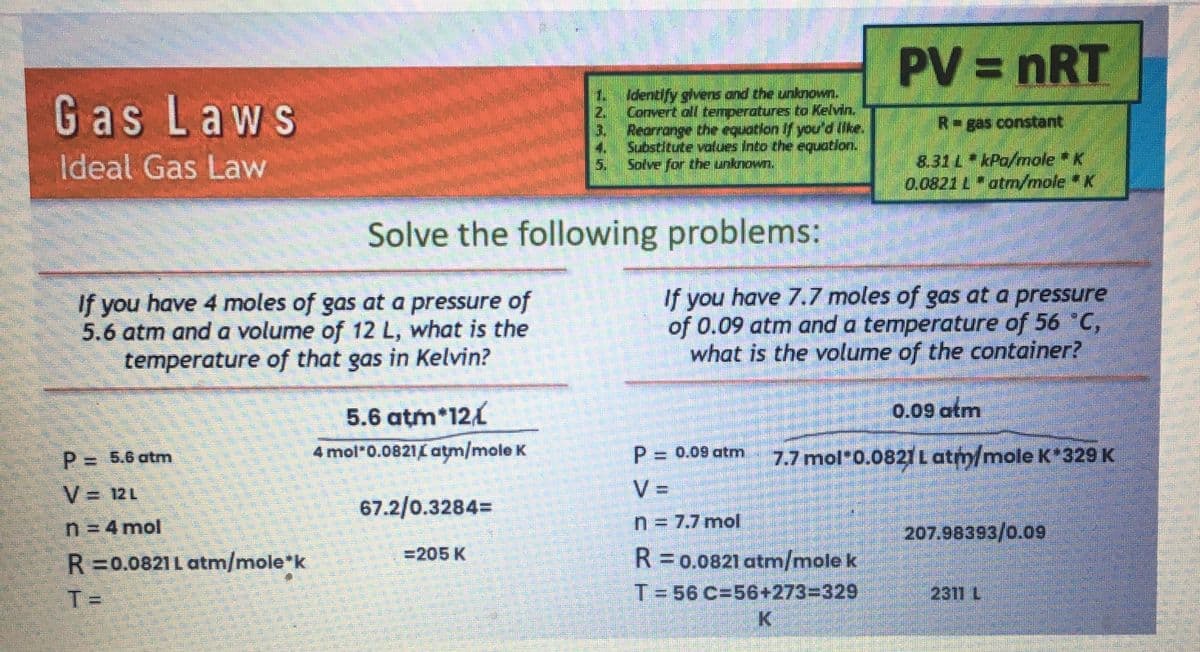Gas Stoichiometry Scenario #3 What mass (in grams) of sodium chloride (NaCl) will be produced when enough sodium (Na) is combined with 2.4 L of chlorine gas (Cl₂) at 25 C and 1.2 atm? Na + Cl₂ ⇒ NaCl 2. Check for STP. 1. Check for a balanced chemical equation. If it's not balanced, balance it. This is important for mole ratio if you'll need it. . R = gas constant 8.31 L kPa/mole * K 0.0821 L atm/mole * K PV = nRT 3. Are you given liters or grams? If there's not STP (0 C, 1 atm), you'll need to use Ideal Gas Law to find "V" or "n". If you're given liters, change to moles using the Ideal Gas Law. Once you have moles, you can use mole ratio and molar mass stoichiometry to determine a mass for the product. If you're given grams, change to moles using molar mass and apply a mole ratio to determine "n" for the other chemical. Once you have "n" for the other chemical, you can use the Ideal Gas Law to solve for "V".
Gas Stoichiometry Scenario #3 What mass (in grams) of sodium chloride (NaCl) will be produced when enough sodium (Na) is combined with 2.4 L of chlorine gas (Cl₂) at 25 C and 1.2 atm? Na + Cl₂ ⇒ NaCl 2. Check for STP. 1. Check for a balanced chemical equation. If it's not balanced, balance it. This is important for mole ratio if you'll need it. . R = gas constant 8.31 L kPa/mole * K 0.0821 L atm/mole * K PV = nRT 3. Are you given liters or grams? If there's not STP (0 C, 1 atm), you'll need to use Ideal Gas Law to find "V" or "n". If you're given liters, change to moles using the Ideal Gas Law. Once you have moles, you can use mole ratio and molar mass stoichiometry to determine a mass for the product. If you're given grams, change to moles using molar mass and apply a mole ratio to determine "n" for the other chemical. Once you have "n" for the other chemical, you can use the Ideal Gas Law to solve for "V".
General Chemistry - Standalone book (MindTap Course List)
11th Edition
ISBN:9781305580343
Author:Steven D. Gammon, Ebbing, Darrell Ebbing, Steven D., Darrell; Gammon, Darrell Ebbing; Steven D. Gammon, Darrell D.; Gammon, Ebbing; Steven D. Gammon; Darrell
Publisher:Steven D. Gammon, Ebbing, Darrell Ebbing, Steven D., Darrell; Gammon, Darrell Ebbing; Steven D. Gammon, Darrell D.; Gammon, Ebbing; Steven D. Gammon; Darrell
Chapter3: Calculations With Chemical Formulas And Equaitons
Section: Chapter Questions
Problem 3.141QP: A power plant is driven by the combustion of a complex fossil fuel having the formula C11H7S. Assume...
Related questions
Question
Solve EXACTLY like the example attached.

Transcribed Image Text:Gas Stoichiometry Soenario #3
What mass (in grams) of sodium chloride (NaCl) will be produced when enough sodium (Na) is
combined with 2.4 L of chlorine gas (Cl₂) at 25 C and 1.2 atm?
Na + Cl₂ ⇒ NaCl
1. Check for a balanced chemical equation.
.
2. Check for STP.
If it's not balanced, balance it. This is important for mole
ratio if you'll need it.
R = gas constant
8.31 L kPa/mole * K
0.0821 L* atm/mole * K
3. Are you given liters or grams?
PV = nRT
If there's not STP (0 C, 1 atm), you'll need to use Ideal Gas
Law to find "V" or "n".
.
If you're given liters, change to moles using the Ideal Gas Law.
Once you have moles, you can use mole ratio and molar
mass stoichiometry to determine a mass for the product.
If you're given grams, change to moles using molar mass and
apply a mole ratio to determine "n" for the other chemical.
Once you have "n" for the other chemical, you can use
the Ideal Gas Law to solve for "V"."

Transcribed Image Text:Gas Laws
Ideal Gas Law
If you have 4 moles of gas at a pressure of
5.6 atm and a volume of 12 L, what is the
temperature of that gas in Kelvin?
P = 5.6 atm
V = 12 L
n = 4 mol
R = 0.0821 Latm/mole*k
T=
5.6 atm*12,
4 mol*0.0821/ atm/mole K
Solve the following
67.2/0.3284=
1.
2.
= 205 K
3.
4.
5.
Identify givens and the unknown.
Convert all temperatures to Kelvin.
Rearrange the equation if you'd like.
Substitute values into the equation.
Solve for the unknown.
PV = nRT
R-gas constant
8.311 kPa/mole K
0.0821 Latm/mole K
problems:
If you have 7.7 moles of gas at a pressure
of 0.09 atm and a temperature of 56 °C,
what is the volume of the container?
0.09 atm
P = 0.09 atm 7.7 mol*0.0821 L atm/mole K*329 K
V=
n = 7.7 mol
R = 0.0821 atm/mole k
T= 56 C=56+273=329
207.98393/0.09
2311 L
Expert Solution
This question has been solved!
Explore an expertly crafted, step-by-step solution for a thorough understanding of key concepts.
Step by step
Solved in 3 steps with 2 images

Knowledge Booster
Learn more about
Need a deep-dive on the concept behind this application? Look no further. Learn more about this topic, chemistry and related others by exploring similar questions and additional content below.Recommended textbooks for you

General Chemistry - Standalone book (MindTap Cour…
Chemistry
ISBN:
9781305580343
Author:
Steven D. Gammon, Ebbing, Darrell Ebbing, Steven D., Darrell; Gammon, Darrell Ebbing; Steven D. Gammon, Darrell D.; Gammon, Ebbing; Steven D. Gammon; Darrell
Publisher:
Cengage Learning

World of Chemistry
Chemistry
ISBN:
9780618562763
Author:
Steven S. Zumdahl
Publisher:
Houghton Mifflin College Div


General Chemistry - Standalone book (MindTap Cour…
Chemistry
ISBN:
9781305580343
Author:
Steven D. Gammon, Ebbing, Darrell Ebbing, Steven D., Darrell; Gammon, Darrell Ebbing; Steven D. Gammon, Darrell D.; Gammon, Ebbing; Steven D. Gammon; Darrell
Publisher:
Cengage Learning

World of Chemistry
Chemistry
ISBN:
9780618562763
Author:
Steven S. Zumdahl
Publisher:
Houghton Mifflin College Div


Chemistry: An Atoms First Approach
Chemistry
ISBN:
9781305079243
Author:
Steven S. Zumdahl, Susan A. Zumdahl
Publisher:
Cengage Learning

Chemistry
Chemistry
ISBN:
9781305957404
Author:
Steven S. Zumdahl, Susan A. Zumdahl, Donald J. DeCoste
Publisher:
Cengage Learning

Chemistry & Chemical Reactivity
Chemistry
ISBN:
9781337399074
Author:
John C. Kotz, Paul M. Treichel, John Townsend, David Treichel
Publisher:
Cengage Learning